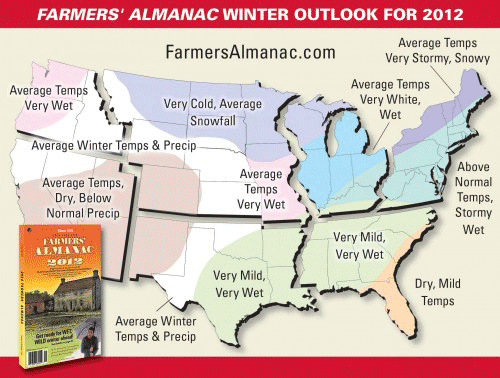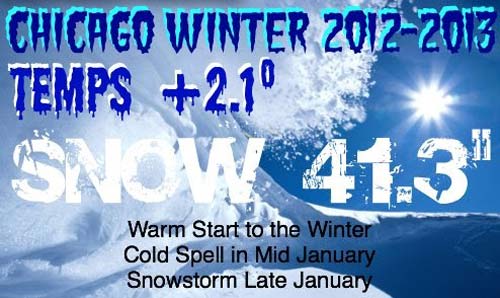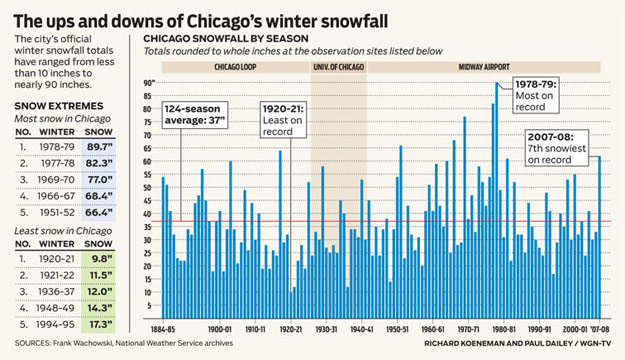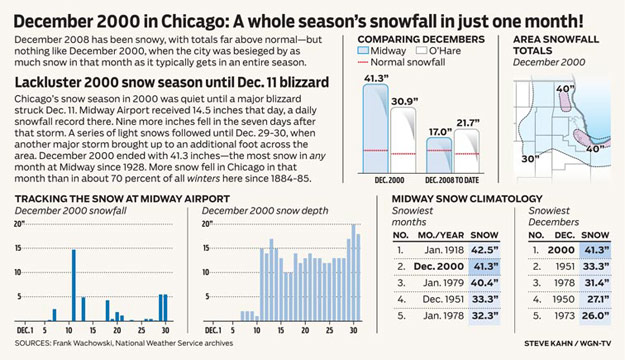
2012 / 2013 Winter Predictions
Could Elusive EL Nino Mean Big Snows for Chicago This Winter?


Learn About the Chicago Weather Before You Get Stuck!
- Chicago snow: On January 14, 1979, Chicago was in the midst of a 7-day period (Jan. 11-17) during which 25.6 inches of snow blanketed the city.
- Chicago temperature surprise: Based on Midway and O'Hare data, daily high temperatures in the 60s occur more often in the city during December than during July.
- Chicago's autumn snow records: In records dating from 1884, Chicago's earliest trace of snow: September 25 in 1928 and also 1942; earliest inch of snow: 1.8 inches on October 19, 1989 (recorded at Midway Airport).
- Chicago's average cold arrival dates in autumn: Using Midway data (1928-2003), Chicago experiences its first autumn temperature in the 30s on Oct. 5; freezing (32 degrees) on Oct. 23; in the 20s on Nov. 2.
- Chicago's average first freeze date: The average date of Chicago's first freezing temperature in the autumn varies considerably across the metropolitan area, occurring earliest in outlying areas and latest downtown. The range is from October 11 (O'Hare) to November 6 (Loop).
- Chicago's winter temperature extremes: Based on official temperature records dating from 1871, the city's highest winter temperature is 75 degrees (February 27, 1976) and the lowest is -27 (January 20, 1985); that is a range of 102 degrees.
- Chicago's snow season: July and August are the city's only totally snow-free months. Traces of snow have fallen as late as June 2, 1910, and as early as September 25, 1928 and 1942. Because June is considered to be a summer month, it is true that snow has occurred here in every season.
- Chicago's snow extremes: Greatest snowstorm, 23.0 inches January 26-27, 1967; snowiest and least-snowy winters, 89.7 inches 1978/79 and 9.8 inches 1920/21; greatest snow depth on ground, 29 inches January 14, 1979.
- Chicago's lowest wind-chill temperature: Bitterly cold temperatures and vicious winds gripped Chicago on January 20, 1985. Early-morning temperatures between -20 and -27 in combination with biting northwest winds 25 to 35 m.p.h. briefly produced a wind-chill temperature of -93 degrees, the lowest ever recorded in Chicago.
Chicago Snow Facts
(based on 124 years of snow statistics beginning with the winter of 1884-85)
(According to National Weather Service & WGN Weather Center)
8.2 inches
On average, that is the largest snowstorm that Chicago can expect in any given winter season. In Chicago, the winter's biggest snowstorm has ranged from a puny 2.4 inches during the 1921-22 snow season to 23.0 inches in 1966-67.
Measurable Snow:
Average Date: November 16th
Earliest: October 18, 1989 (0.7 inches)
October 18, 1972 (0.2 inches)
Latest: December 16, 1965 (0.3 inches)
Seasonable Snowfall
| Average Snowfall from Fall through Spring (1971-2000): | 38.0 inches |
| Least amount of snowfall: | 9.8 inches (1920-1921 season) |
| Greatest amount of snowfall: | 89.7 inches (1978-1979 season) |
Oddly, the city's two least snowy winters and its two most snowy winters were each back-to back affairs. The winters of 1920-21 and 1921-22 brought 9.8 and 11.5 inches, respectively; the snowiest winters, 1977-78 and 1978-79, put down 82.3 and 89.7 inches, respectively.


2 Inch Snowfalls: Chicago's snow records date back 124 seasons to the winter of 1884-85, and the long-term averages show that the city receives measurable snowfall (0.1 inch or more) on 29 days each cold season and a snowfall of 2 inches or more on six occasions. Of course, those numbers can vary tremendously depending upon the nature of the winter. The city has never gone through a winter without a 2-inch or greater snowfall but on two occasions, first in the winter of 1921-22 and again in 1936-37, there was only one such event. Compare that to the 15 2-inch-plus snowfall events during the snowy winter of 1977-78, and you get an idea of the winter-to-winter variability in snowfalls that Chicago has experienced.
Six-inch snowstorms: a child's delight and a motorist's nightmare. Chicago has its share of such storms, to be sure, but, given its reputation as a cold and snowy Midwestern city, not as many as one might suppose. Chicago weather historian Frank Wachowski cracked open the record books to provide the following snowy statistics. Based on 80 years of snowfall data compiled at Midway Airport since 1928, the city has logged 112 snows of 6 inches or greater, an average of 1.4 per winter season. Here's the monthly breakdown: November, 3 storms; December, 30; January, 25; February, 26; March, 24; April, 4. Two surprises: April leads November; and December, only the city's third-coldest month (behind January and February), leads the pack.
A total of 3,063.0 inches of snow was measured at Midway Airport in the 79-year period from 1929 through 2007. That works out to an average of 38.8 inches per year. Measurable snow has occurred there as early in the snow season as Oct 12 (0.3 inch in 2006) and as late as May 11 (0.2 inch in 1966). Jan. 13 stands as Chicago's snowiest day, with a total accumulation of 54.6 inches in the 79 years of Midway snow data. Jan. 26 ranks second with 51.5 inches. The snowiest single day, midnight to midnight, in Chicago snow history is Jan. 2, 1999, when 17.6 inches buried the city. That day was part of an epic Jan. 1-3 storm that delivered 20.6 inches.
Blizzard vs. Snowstorm: Despite the fact that the National Weather Service has strict guidelines for qualifying a storm as a blizzard, the term is often erroneously applied to snowstorms that don't fit the bill. The two key factors in categorizing a storm as a blizzard are wind and visibility. Winds need to reach sustained speeds or frequent gusts of 35 m.p.h. or greater, and visibilities have to be repeatedly reduced to 1/4 mile or less by falling and/or blowing snow for a period of at least three hours. A blizzard can actually occur with clear skies if the visibility reduction is caused by blowing snow. While there are no temperature requirements for a blizzard, the combination of strong winds and below-freezing temperatures will drop windchills at least into the single digits.
Eating Snow - Not a Good Idea: It's not a good idea because snow contains potentially harmful airborne pollutants. It's not that snow is immediately toxic, but it can contain chemicals that you don't want to put into your body. Here are the opinions of two experts. University of Toronto environmental chemist Dr. Frank Wania reports that the atmosphere is exceedingly efficient at transporting pollutants -- so efficient, in fact, that industrial pollutants released into the atmosphere in India could be found in snow in northern Canada only five days later. Argonne National Laboratory's Dr. Jeff Gaffney is more specific. He says snowflakes can contain anything that floats in the air: the chemicals that fall in acid rain, bacteria, sulfates, nitrates and even lead from areas in the world that still burn leaded gasoline.
The winter of 1978-79 was Chicago's worst. It boasts an all-time record 89.7 inches of snow, plus a record 100 consecutive days of snow cover from Nov. 26 to March 5. December was very snowy with 31.4 inches accumulating, including a New Year's Eve blast that brought 7.6 inches. But that snowstorm was the famed "Blizzard of 79" that dumped 21.0 inches of snow on Chicago from Jan. 11-14, bringing the city to a standstill. Snow was piled so high that people tied flags to their cars so they could be seen as they approached snow-clogged intersections. Side streets were impassible, and many cars could not be moved until the snow finally melted.








